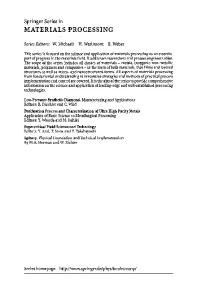Ion-Beam Analysis of Polymer Surfaces and Interfaces
- PDF / 829,516 Bytes
- 6 Pages / 576 x 777.6 pts Page_size
- 71 Downloads / 383 Views
Ion-Beam Analysis of Polymer Surfaces and Interfaces Edward J. Kramer Introduction Ion-beam analysis of chemical composition as a function of depth is by now well-established for inorganic materials and is an important method of investigating growth of thin films.1'2 It has been applied to polymers much more recently, perhaps because fairly obvious problems with radiation damage discouraged workers in this field initially. Ion-beam analysis has developed, however, into a analytical tool that complements other methods, such as x-ray photoelectron spectroscopy and neutron reflection, very well. The purpose of this short article is to give the reader an introduction to its current uses in polymers. The ion beams of ion-beam analysis are typically highly energetic (1-5 MeV) beams of 4He++. While other beams are used, for example, 3He and 15N, alpha particle beams are used in the vast majority of experiments reported in the literature. Two major categories of experiments are carried out with such beams. Rutherford backscattering (RBS) spectrometry1'2 to detect heavy elements in the polymer and forward recoil spectrometry3'4 (FRES) (also known as elastic recoil detection3) to detect the isotopes hydrogen and deuterium. The basic principles for each method are similar. Rutherford Backscattering Spectrometry In an RBS experiment, the ion beam impinges on the sample, as shown in Figure la, and 4He particles backscattered from heavier nuclei in the sample are detected in a backward direction (e.g., at 171° to the incident beam direction) with a surface-barrier semiconductor-diode detector that produces a current pulse whose height is proportional to the energy of the 4He particle. The energy of the particle encodes both the mass of the nucleus that caused the
MRS BULLETIN/JANUARY 1996
RBS
energy sensitive detector
polymer film sample
FRES
polymer film sample 4
He++
absorber
energy sensitive detector
polymer film sample 4
TOF-FRES
He + carbon foil
electron \ / multiplierV/
energy sensitive
start signal
stop signal
Figure 1. (a) Schematic of the geometry of Rutherford backscattering (RBS) spectrometry. (b) Schematic of the geometry of forward recoil spectrometry (FRES). (c) Schematic of the geometry of time-of-flight FRES.
37
Ion-Beam Analysis of Polymer Surfaces and Interfaces
fraction of incident ions backscattered per unit energy per steradian) of backscattered 4He from a given nuclear species at a certain depth depends linearly on the product of the concentration of the nucleus and its RBS cross section. Since the cross section depends on the charge Z of the nucleus as Z 2 for Rutherford scattering (scattering from the charge on the nucleus), the RBS technique is much more sensitive to heavy elements than to light ones. If the energies of 4He scattered from various nuclei do not overlap, it is relatively straightforward to convert the yield-versus-energy curve that constitutes the Rutherford-backscattering spectrum into concentration-versus-depth profiles for those elements. A standard software package5
Data Loading...








